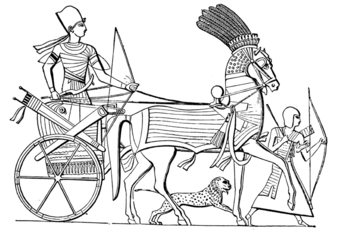Chariot: Difference between revisions
imported>Howard C. Berkowitz (Needs work on the military -- cavalry is a much broader term, and chariots were a form of cavalry) |
Pat Palmer (talk | contribs) |
||
| Line 13: | Line 13: | ||
==In mythology== | ==In mythology== | ||
In [[Greek mythology]], chariots were useful in [[warfare]]. In [[Ancient Rome|Roman]] [[poetry]] such as the ''[[Aeneid]]'' by [[Virgil]], the [[Greek god|goddess]] [[Juno]], who loved [[Carthage]], kept a war chariot there hoping that her beloved [[city-state]] would one day rule the [[Mediterrean Sea|Mediterranean world]];<ref name=Virgil3>{{cite news | In [[Greek mythology]], chariots were useful in [[warfare]]. In [[Ancient Rome|Roman]] [[poetry]] such as the ''[[Aeneid]]'' by [[Virgil]], the [[Greek god|goddess]] [[Juno (mythology)|Juno]], who loved [[Carthage]], kept a war chariot there hoping that her beloved [[city-state]] would one day rule the [[Mediterrean Sea|Mediterranean world]];<ref name=Virgil3>{{cite news | ||
|title= Virgil: Aeneid Book 1 Virgil's theme: a man dogged by the implacable hatred of an unforgiving goddess. | |title= Virgil: Aeneid Book 1 Virgil's theme: a man dogged by the implacable hatred of an unforgiving goddess. | ||
|publisher= the classics pages | |publisher= the classics pages | ||
Revision as of 13:54, 24 February 2023
A chariot was an invention from ancient Mesopotamia in which two or four wheels were attached to an axle or axles and permitting a cart to be built on top; this structure was attached to a horse or horses by ropes or wooden bars. A human could ride in the cart and be pulled by the horses at a rate of speed much faster than walking.
Technology
It was an important development in transportation and warfare and military technology, since it permitted rapid attacks and movements, and a warrior would be higher up than a foot soldier and could attack using a bow and arrow, spear, mace, club, or other weapon. Archaeologists and historians have evidence of chariots dating before 3000 BCE, although there is dispute whether the chariot was invented by the Hittites, Mesopotamians, Egyptians, or others, and some sources suggest the earliest chariots were developed in an area north of Iran in modern Russia. A key invention permitting the chariot was when wheels had spokes, making them lighter in weight.
Sport
Chariots were also used in races, by messengers, by nobility.
Military
When horse breeding advanced to a point where larger horses could support mounted warriors, chariots became less valuable, and were replaced by cavalry.
The term, however, has a long military tradition. In the Second World War, miniature submarines, derived from torpedoes, ridden by divers, were used to attack ships.
In mythology
In Greek mythology, chariots were useful in warfare. In Roman poetry such as the Aeneid by Virgil, the goddess Juno, who loved Carthage, kept a war chariot there hoping that her beloved city-state would one day rule the Mediterranean world;[1] but this was not fated to happen, since Rome was founded (according to the epic poem) by the hero Aeneas.
Music
"Jerusalem", the well-known hymn based on the poem "And did those feet in ancient time" by William Blake, conains the line,
Bring me my Spear: O clouds unfold: Bring me my Chariot of fire!
Literature
Chariots of Fire is a 1981 film, directed by Hugh Hudson. It explores the selection of the 1924 British Olympic team, their preparation, exploits and their eventual accomplishments.
References
- ↑ Virgil: Aeneid Book 1 Virgil's theme: a man dogged by the implacable hatred of an unforgiving goddess., the classics pages, 2010-04-18. Retrieved on 2010-04-18.
